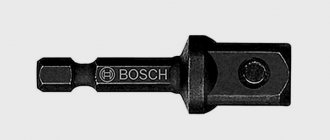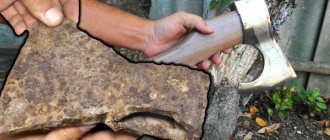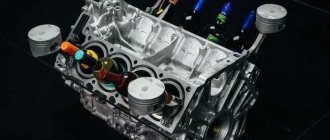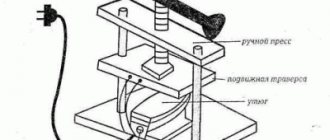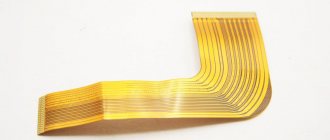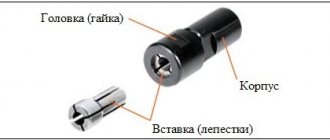It will take no more than half an hour to make a duplicate. This is why this lesson is valuable: having neither knowledge in locksmith work nor experience, it is possible to create a replacement for a key. At least once, such a master key will help out, but there’s no need for more: our method is an emergency, and such cases often don’t happen, otherwise you’ll still need to find a locksmith.
Pay attention to the type of tin can. As we said above, you will need a more serious option than those in which drinks are poured. For preservation, the container is thicker than for lemonade. Tin cans made of fairly dense tin are suitable for us.
Well, the fact remains: this method is not for bulky master keys; only flat keys can be quickly duplicated from a tin blank.
Let's get down to business. Examine the key. Please note that it does not have symmetry in one of the planes, because the teeth seem to adhere to one of the sides if you put the key on a flat surface.
It is from this side that we will take the “measurement”. Take a lighter and “smoke” the key. Our task is to ensure that the soot covers the entire surface of the metal. Be careful not to get burned! I remember we included pliers among the tools: use them to hold the key while smoking.
Once you have achieved what you want, put the key aside. Let the metal cool. At this time, prepare the tape. We need a strip that at least covers the surface of the key, which we have treated with fire.
Apply tape to the cooled key with the sticky side facing the soot and run your fingers over it, enhancing adhesion. The next step is to carefully remove the tape. In our hands we have nothing more than a semblance of a cast, but in fact just an imprint.
By the way, if you come up with another way to take such a fingerprint, you can implement it. The main thing is to get a template according to which we will cut out a duplicate for ourselves.
The sticky side of the tape is applied to the tin. Before us are the contours of a key along which we cut the tin with scissors. Here it is important not to rush, so as to repeat all the cloves one by one. And don't forget to cut out the part of the key that you will hold with your fingers.
Be sure to bend the cut duplicate with pliers, because during the cutting process we involuntarily deform the even plane. Now the duplicate is completely ready for use. We don’t promise that it will last a long time, but the homemade product will work at least once: a fact that we personally verified.
Using a homemade master key, you may find that the key does not fit into the keyhole. Overcome the obstacle by tugging the key back and forth and up and down to move the teeth through the entire hole of the moving “steps” of the lock.
When turning the duplicate, hold it with your fingers as close to the lock as possible so that the tin does not bend during the turning process.
Let us immediately warn you that our advice is not for “shady” matters; do not even think about using the master class in order to violate current legislation. Open only those locks that conceal your property.
If you want such a master key to last longer, choose a denser metal and the appropriate scissors for it, and you will definitely succeed.
Source: https://sam-sebe-molodec.ru/2018/08/09/kak-sdelat-dublikat-kljucha-za-15-minut/
How are keys made?
Making keys at a factory is not a tricky process. For this purpose, special equipment is used that stamps blanks that are adjusted to the secret part of the locking mechanism in an automatic, production mode. However, quite often there is a need to make a duplicate key at home, using a cast for this. Below, we will describe in detail how keys are made from an impression.
Making a high-quality key impression
Let's start making a cast. There are several methods, but we will talk about the one that involves quickly producing a key blank.
To do this you will need a set of the following tools and materials:
- any lubricant;
- a thin metal sheet about 10 cm, the width of which corresponds to the key;
- ordinary children's plasticine.
As you can see, you don’t need any complicated items. Metal plates can be purchased at hardware stores. As a last resort, you can get by with a metal ruler, if you don’t mind using it for such purposes.
In order to get an impression, apply a thin layer of plasticine no more than one and a half millimeters thick to a metal plate. The plasticine is lubricated with oil to prevent it from sticking to the key. Press the key onto the plasticine so that it leaves a clear, even imprint. Based on the casts obtained, a blank is cut out of a metal plate, onto which a key is cut.
Another way to get a key blank is to carefully and carefully measure all the dimensions of the cast made with an accurate ruler, put the data on a sheet of paper and make a drawing. There can be no talk of any approximation - the drawing must be as accurate and correct as possible.
Let's start making the key
So, we already have a drawing or a blank on a metal plate, and therefore we can now begin to describe the process of how keys are made.
To make a copy of a key, you need to purchase two key blanks that are copied
To do this, you need to purchase two key blanks that are copied. This can be done in any store that specializes in selling lock hardware. Simply knowing the model and type of door lock is enough. You can select the workpiece visually, from memory. Or take the original key with you, which will allow you to choose a blank that matches the original as closely as possible.
Now it’s a matter of small but painstaking work. Working with a file or needle file, you need to cut out all the notches of the key. There is no need to rush, be careful and avoid sharp edges. The notches should exactly match your drawing or blank on the metal plate.
Keep in mind that it is always a little more difficult for the duplicate to penetrate the keyhole than the original key, and therefore it is so important to make all corners and edges rounded. But don’t get carried away with the work process, otherwise you should remove at least an extra half a millimeter and the workpiece will be damaged
Of course, you have a second blank, prudently purchased at the store, but the time spent will be lost forever.
Now you know how keys are made. You don't have to go to a workshop to do this. If you have free time and a certain dexterity and perseverance, you can make a key yourself.
The squeezing method is popular among emergency services.
If you have lost the key, cannot get into the room, and the second one is not at hand, then you can try to open the door using a method popular with emergency services - this is the so-called pressing method. It is real only if you have a cylinder type of constipation installed. Although to implement it you will need some tools:
- vice;
- a good file with thin edges;
- pliers.
Before making a door key
pressing method must be purchased. In its type and appearance it must exactly match the original. You can purchase such blanks in construction, hardware stores or key shops - just name the lock model and the seller will offer you the required blank. If you don’t remember the name of constipation, then select it from memory.
So, if the workpiece has been purchased, the neighbors have a vice or in the garage, you can get to work. To do this, carefully insert the blank into the keyhole so as not to damage the internal pin mechanism. Holding the head of the key with pliers, carefully turn the blank to the right, as if you were going to lock the door. Do not press too hard, as soon as you feel that it is no longer turning, stop and move it up and down. Then do exactly the same manipulations, but turning the key to the left. This will allow you to get clear fingerprints.
Secure the workpiece in a vice and use a file to remove the excess metal on the key, focusing on the marks obtained. Work carefully so as not to cut off any excess. It’s better to periodically insert the key into the keyhole and try to open the door; if you can’t, take the file again. All corners and cutouts must be perfectly smooth, with sharp corners.
This is one way to make a door key
, but there are others. About them, as promised, below.
Making your own key machine
DIY car radiator repair
Features and types of key machines
Copy milling machines differ from each other in functional characteristics.
According to the characteristics of making duplicates, there are several types:
- universal - with their help it is easy to grind products of any configuration, including magnetic ones - suitable for the intercom. This is a popular equipment equipped with a numerical control unit;
- special devices allow you to make keys of one type.
Devices of a highly specialized type are designed to produce duplicates of a specific developer. The type of milling equipment depends on the position of the processing tool. Milling machines for making keys come not only with one working cutter. Several cutting tools simultaneously process a number of surfaces. Before choosing suitable equipment and making it yourself, you should decide on the type of duplicate.
A key milling machine consists of several main structural parts. A copying unit equipped with a spike probe that is in contact with the surface of the original. The element allows the cutter to make an exact analogue. The workpiece is moved relative to the cutting tool by the work table. The trajectory can be transverse or longitudinal.
The key cutting machine is equipped with additional tools:
- a set of needle files - files with a fine notch, with the help of which the product is cleared of burrs and acquires its appearance;
- measuring instruments for determining accuracy;
- An electrical system with a customization function allows you to make options for car keys with an electronic card.
The process of making a key machine with your own hands
To assemble the key machine you will need a special vice, a machine for cutting grooves, a metal blank, a file
To make the machine yourself, you do not need any special equipment. The device is equipped with a holder made of pipes, the internal diameter of which corresponds to the size of the metal workpiece. The milling device can be supplemented with a wooden beam with holes of different diameters. An important element of this design is the tool rest, which fixes the workpiece relative to the surface of the grinding wheel.
In this case, you need to adhere to several rules:
- structural parts must be firmly fixed;
- the design allows parts to be processed manually or semi-automatically;
- The tool rest allows for the position of the metal workpiece at any angle.
There are two simpler ways to make analogue products.
The first option for making a key machine at home:
- you need to prepare metal 2 mm thick, two vices, a hacksaw, a hand drill, a flat file, calipers, flat, round, square needle files;
- Make a rectangular template from metal. Process with a file. Secure with a vice;
- Drill a hole in the upper part with a drill, and cut out recesses in the lower part with a hacksaw. This way you can make any product for a castle.
The second option for making a machine for keys at home. To assemble the machine, you will need a special vice, a machine for cutting grooves, a metal blank, and a file.
The technology for making duplicate keys is as follows:
- the template is secured in a vice using a clamp and a hexagon at the top;
- the recess is knocked out with a file;
- The holes are machined out using a machine.
A key milling machine requires compliance with safety regulations.
- https://akak.ru/recipes/20101-kak-srochno-sdelat-vremennyiy-dublikat-klyucha
- https://sovetiposekretu.ru/285-kak-sdelat-dublikat-klyucha-svoimi-rukami.html
- https://www.lock-door.ru/pub/view/kak-delayut-klyuchi-ponyatnaya-instrukciya-neslozhnogo-processa
- https://moybiznes.org/izgotovlenie-klyuchej
- https://how.qip.ru/dom-i-sad/drugoe-po-teme-dom-i-sad/kak-byistro-sdelat-slepok-klyucha
- https://metmastanki.ru/stanok-dlya-izgotovleniya-klyuchej
- https://zakustom.ru/dublikat-klucha.html
- https://promzn.ru/stanki-i-oborudovanie/izgotovlenie-stanka-dlya-klyuchej.html
Erasers in Yaroslavl
- Stationery accessories
- Black lead pencils
- Erasers
- Elastic bands, headbands, hair bands
Pilot Eraser
Factis eraser large Extra Soft 61x24x13 mm, holder (CPFES20)
Elastic band LUXEZY Spirals 3 pcs.
Elastic band Studio Style 45893-4391 3 pcs.
Eraser KOH-I-NOOR 120 mm, retractable, plastic case (9736000002PS)
Elastic band Studio Style 45925-4397 3 pcs.
Eraser eraser BRAUBERG “Energy”, triangular, plastic holder, 10x45x45 mm, white, 222473
Elastic band Invisibobble ORIGINAL (3042) 3 pcs.
Brauberg erasers, set of 3 pcs., gray-white
Elastic band Beauty Bar bracelet 3 pcs.
Eraser eraser Stabilo “Animals”, assorted, in display, 1188/48LA
Eraser/Eraser soft EXTRA Factis
Elastic band Invisibobble SLIM (3097) 3 pcs.
Eraser eraser “Elephant”, 31x21x8 mm
Eraser eraser “Elephant”, 31x21x8 mm
Elastic band Invisibobble POWER (3053) 3 pcs.
Eraser/Eraser Pilot 1 pc.
Brauberg “Blaster” eraser, in a plastic case, retractable (223593)
Brauberg eraser, oval, assorted
Eraser/Eraser Cactus
Eraser Factis rectangular, 52x20x7 mm, synthetic rubber
Eraser eraser Factis Softer 56x24x14 mm, cardboard holder, synthetic rubber (CMFS20)
Eraser eraser BRAUBERG “Energy”, triangular, plastic holder, 10x45x45 mm, white, 222473
BRAUBERG erasers, set of 3 pcs., 41x14x8 mm, gray-white, in a package with hanger (48 pcs.)
Laco eraser
Set of erasers Pilot, 45x20x12 mm (set includes 36 erasers) (number of items included: 36)
How to urgently make a temporary duplicate key
Immobilizer Lada Priora VAZ 2170 - design features, key training, actions if keys are lost, additional functions
Sometimes it happens that keys are lost, and at this time they are urgently needed. Of course, you can make a duplicate, but it takes time. Here is a method in which a “temporary” duplicate can be made in ten minutes without leaving home. It turns out that opening and closing the door a couple of times is enough, but sometimes this is enough. What you will need: original key, aluminum can, scissors.
We cut out the resulting workpiece with scissors and level it so that it is straight without bends.
Instructions for making a duplicate key:
- take an aluminum can. Cut off the neck and bottom of the jar. From the remaining part we cut out a rectangle, larger in size than the key we will make;
- Since the jar was round, the workpiece turned out to be curved. She needs to be straightened out. This can be done by placing it on a flat surface and smoothing it out;
- We apply the key to the clean, unpatterned side and circle it with something sharp and hard. You need to circle as close to the key as possible;
- cut out the resulting workpiece with scissors and level it so that it is straight, without bends;
- Now we connect the workpiece and the key;
- We pass along the workpiece with a sharp, hard object, in the place where the groove runs. This must be done carefully and several times until the groove is the same as on the key. We repeat the same operation on the other side, if there is a groove there too.
All! The duplicate is ready! You can open or close the door. If the lock on the door is difficult to operate, use something flat, such as a screwdriver, to open and close it. It is inserted into the lock lightly and the main force, when turning the key, rests on it. Then there will be no preparation.
Opening the door using a tin can
The next way to make a door key
also suitable for cylinder locks, but only those with easy and smooth bolt action. You will also need the original key.
So, for the second method of making a key you will need:
- a tin plate or a can of Pepsi, Cola, etc.;
- pen or sharp, thin pencil;
- scissors.
Cut a rectangular plate from the can, the size of which will be slightly larger than the size of the key. Place the plate on a hard surface, attach the key to it and carefully, as accurately as possible, trace it with a pen or pencil. Cut out the resulting outline. Again, you need to work carefully so that the scissors do not “go” beyond the contour. After you finish cutting, attach the resulting outline to the key and check whether the resulting copy matches the original. Using a pencil or pen, trace the cut out outline where there is a groove on the original key. Naturally, leaving the attached outline to the original.
Insert a copy of the key from the tin into the keyhole and carefully turn the cylinder so as not to break or bend the product. If it opens easily, then unlocking it with a tin outline will be quite simple.
Now you know the second way to make a door key
.
What is a chip key
How much does it cost to restore STS? How to restore a vehicle registration certificate
Almost all cars since 1995 are equipped with an anti-theft system and have a standard immobilizer. The key in these cars contains a transponder, that is, to start the engine, an ignition key with a chip is required. If a spare key is made for you in a workshop, then it will only be able to open the doors, but the engine will not start. In addition to the mechanical part of the key, you also need to copy the chip. At first glance, it may seem that another key is not needed, but believe me, making an additional key with a transponder is a pittance compared to how much time, nerves and money you will have to spend if the last key is lost or broken! We copy most chip keys that exist. Also, if necessary, we will repair your key, replace the buttons or key body, and provide any services in this area. Making a key with a chip will take from 10 to 30 minutes. Also today, alarms with auto start are very common; it is quite convenient in winter to start the car without leaving home, wait until it warms up, and then get into a warm car. BUT if the car is equipped with an immobilizer, then it is necessary that the key with electronics be in the car, and this, as you understand, carries a certain risk, so it is better to make a chip for autostart, so as not to leave the entire working key in the car, but only insert the chip in the immobilizer bypass.
Features of the nag
A soft eraser is an indispensable tool for conveying halftones and highlights. Unlike vinyl or rubber, which were familiar from school days, it is flexible, easily stretched and compressed. The nag changes shape like plasticine. Some artists even use it for other purposes and create figurines and entire sculptures with which they decorate their desktop.
The eraser is also used for entertainment. If you roll the mass into a ball and throw it on the floor, it will bounce like a ball. Although in a couple of such bounces the nag will collect all the dust and dirt. Therefore, instead of laughing, you will want to start cleaning. But it’s better to understand in advance that a drawing stick is not a toy, but an important artist’s tool. Therefore, it is advisable to still use it for its intended purpose. And for games, choose something else.
Chip key programming
When creating new chip keys, it is necessary not only to create a mechanically accurate copy, but to copy all the necessary information that is in the original so that it can be recognized by the immobilizer unit. The codes contained in the key are individual for each vehicle.
In some cases, in order to read the code, the firmware that the immobilizer is equipped with is initially read.
A duplicate is created based on the data.
To read the firmware, specialized equipment is used.
Thanks to it, it is possible to disable the immobilizer and reprogram the chipped keys.
Our CAN MODULE adapter allows:
To get the code; Program the chip and buttons; Bind the key.
You can program chip keys for any car model, including those with a complex electronic system.
Drawing stick - what is it and how to use it
If you are a novice artist who is just getting acquainted with the world of art and studying materials for drawing, then you may not have heard of nag. Behind this funny name lies an eraser with interesting properties that resembles plasticine to the touch. Let's figure out what it is - a drawing stick, and why an artist needs it. This knowledge will definitely be useful to you when creating works with pencil, charcoal and pastel. You can see what it is - a nag for drawing, in the photo below.
Is it possible to make a key for the lock yourself?
Theoretically, having the necessary tools and materials at hand, you can try to make a key for the lock yourself. If you want to acquire a new hobby and want to spend time on it, then by understanding the mechanism of the locking device and grinding the blank, you will certainly make a normal key. In the vast majority of cases, making a key for a lock is necessary and urgent.
Reading articles on the Internet that claim that anyone can make a key without removing the lock, people begin to try and aggravate the problem by breaking the secret mechanism. In our opinion, if you are going to take on the task of independently making keys for a locking device, then only in accordance with the recommendations of specialists and in a calm environment, with time for this. And always using a professional tool.
If you need to do this work efficiently and urgently, then the best decision would be to turn to specialists. A professional can quickly and efficiently make a key, having full or limited access to the secret mechanism. Full access presupposes the ability to remove and disassemble the locking device, while limited access allows you to only get close to the keyhole.
The specialist will determine the type of locking device. He will evaluate the possibility of making a key and immediately tell you how expensive it will be. This way you will save valuable time and effort
In addition, if there is such a need, a specialist will quickly and professionally open the lock, and you will gain access to the locked room, which is important
What you need to know about the nag before using it
The nag is capable of creating a light balance that rapidly gains shadow or, conversely, creating a diffuse, faded tint of the object. Such an eraser will remove unnecessary strokes from the drawing and make a smooth transition of light and shade. The eraser has an easy-to-use structure. Physical properties make it possible to separate the nag, bring it to a certain elasticity, and use it in different forms. Depending on the manufacturer, the nag may have different colors, but this does not affect its properties in any way. The choice of such an eraser is very important for creating an artistic, competent drawing.
The eraser has a lot of advantages:
Flaws:
- The nag must be stored in cellophane packaging; when opened, it collects dust;
- There is not enough rigidity with deep dark strokes.
How to make duplicate keys
In essence, this is a handicraft production, the essence of which is to make copies to order. The customer himself provides an original sample directly at the time of production.
Key blanks must be made from high quality materials without any defects in the original material
Blanks for making keys must be made of high quality materials, without any defects in the original material. The service life of the copy will depend on the quality of the workpiece itself. Typically, blanks are made of brass and steel.
The master visually selects the most suitable workpiece, comparing it with the original. Then he measures all the parameters of the original using a caliper. Then the process of making the key begins on a special machine. The whole process can be divided into two stages: roughing and finishing of the workpiece.
During the roughing process, excess material is cut off using a rough cutter according to the measured parameters, but with a slight margin. At the second stage, the excess material is cut off using a finishing cutter, which ensures that the dimensions of the manufactured key exactly match the sample. At both stages of key production, there is constant monitoring of the dimensions of the blank, after which the duplicate is ready.
Briefly about the types of locks
When choosing a turnkey blank in a hardware or hardware store, you should take into account that currently there are mainly two types of locks used:
In cylinder locks, the secret mechanism (cylinder) is made in the form of a cylinder with spring-loaded pins located inside. Each pin is divided into two parts of different lengths. The key is made from a flat blank; the working part (bit) has protrusions of different heights. In addition, a longitudinal groove can be made on the beard.
Read also: Tomahawk lr 1010 instructions
Principle of operation
The principle of operation of such a lock is that each protrusion of the inserted key “raises” the corresponding pin to a certain height. In this case, the ends of both parts of the pin are installed strictly on the border of the lock body and the cylinder. The cylinder turns to open the lock. If the key does not match the lock, the pins simply do not allow the cylinder to turn because they are in the wrong position.
The secret part of the lever lock is made of several levers (plates), on which there are several figured cutouts. The key of a lever lock is a round rod with one or two bits located at one end.
The beard also has a certain configuration. It can have a longitudinal groove or protrusion. The secret of the key lies in the presence of cuts (steps) of different heights on the beard. With the help of steps, the levers are deflected by a certain distance, which will allow the lock to be opened.
What is the purpose of duplicators
It is known that the copier uses working electronic chips onto specialized compatible blanks to read and then copy codes. Any number of similar duplicates can be made.
The latest models of copiers provide the opportunity to make magnetic keys for intercoms in the following formats:
- Two-pin (using the TM protocol);
- Contactless cards or key fobs;
- Less common three-pin chips.
They support a fairly wide range of blanks:
- Two-contact blanks;
- Universal;
- Three-pin square;
- Contactless RFID.
Recording of the read code can only be done on specialized blanks, because factory identifiers are not intended for recording new codes.
Basic features of the copier
The following device capabilities can be distinguished:
- Many duplicators offered on the modern market operate from power supplies that come with them or from separate batteries;
- The most advanced models can work with a computer, and if you install the appropriate software, you can maintain the necessary database in which each copy of the key will be described in detail. In addition, the possibility of direct communication with a computer greatly simplifies the process of updating the firmware, thus helping to expand the capabilities of the copier;
- Universal duplicators, which are contact-non-contact, have a specialized platform for reading or writing contact-type chips on their body. You can also make a copy of the contactless key using the corresponding area;
- Some models offered on the modern market provide the ability to visualize the chip copying process using specialized built-in displays;
- Many models have independent memory for a selected number of codes, so you can organize a real database, restoring lost copies even if the original is missing.
The video shows the operation of the key duplicator:
The duplicators offered by the modern market provide every ordinary user with the opportunity to independently copy the key in case of its loss, without being tied to the company that installed the intercom device.
Thus, each person can remove the restriction on the maximum number of chips for one user or for all residents of the house.
The market is constantly expanding, so the demand for such devices is increasing, and the cost of duplicating keys is falling, which is very beneficial for ordinary users.
Comparison table of duplicators and blanks
| Key | TMD-1v3 | RFD 1 | TMD RW-15 | RFD 3 | TMD-3R | TMD-5R | TMD-5S | TMD-6 | SMkey | ||
| SUPPORTED FORMATS | |||||||||||
| Contact | Touch Memory | Dallas | + | — | — | — | + | + | + | + | — |
| Metakom | + | — | + | — | + | + | + | + | — | ||
| Сyfral | + | — | + | — | + | + | + | + | — | ||
| Contactless (RFID) | 125 kHz | EM-Marin | — | + | — | — | + | + | + | + | — |
| HID26 | — | — | — | — | — | + | + | + | — | ||
| HID34 | — | — | — | — | — | + | + | + | — | ||
| HID37 | — | — | — | — | — | + | + | + | — | ||
| Indala | — | — | — | — | — | + | + | + | — | ||
| Urmet | — | — | — | — | + | + | + | + | — | ||
| Electra | — | — | — | — | + | + | + | + | — | ||
| 13.56 MHz | TehKom | — | — | — | + | — | + | + | + | + | |
| Factorial (Ti-256) | — | — | — | — | — | — | + | + | + | ||
| Mifare Ultralight | — | — | — | — | — | — | + | + | + | ||
| Mifare Classic | — | — | — | — | — | — | +! | +! | + | ||
| iCode (Hi-Tag) | — | — | — | — | — | — | + | + | + | ||
| + for older models of intercoms; ! need a crypto key or one open sector | |||||||||||
| SUPPORTED WORKPIECES | |||||||||||
| Contact | Touch Memory | TM08v2 (RW1990 | + | — | — | — | + | + | + | + | — |
| TM2004 | + | — | — | — | + | + | + | + | — | ||
| TM08 Vi-F | — | — | — | — | + | + | + | + | — | ||
| TM08 Vi-2 | + | — | — | — | + | + | + | + | — | ||
| RW1.1 | — | — | — | — | + | + | + | + | — | ||
| RW2017 | — | — | — | — | + | + | + | + | — | ||
| KC-07 | — | — | — | + | + | + | + | — | |||
| RW15 | — | — | + | — | + | + | + | + | — | ||
| TM01A | + | — | — | — | + | + | + | + | — | ||
| DS1996 EEPROM | — | — | — | — | + | + | + | + | — | ||
| TM2004 EEPROM | — | — | — | — | + | + | + | + | — | ||
| Contactless (RFID) | 125 kHz | Blanks with H1 chip | — | + | — | — | + | + | + | + | — |
| Blanks with H2 chip (T55x7) | — | + | — | — | + | + | + | + | — | ||
| Blanks with H3 chip (EM4305) | — | — | — | — | + | + | + | + | — | ||
| Blanks with H5.5 chip | — | — | — | — | + | + | + | + | — | ||
| Blanks with H7 chip | — | — | — | — | + | + | + | + | — | ||
| 13.56 MHz | TKRF, TKRF-v2 | — | — | — | + | — | + | + | + | + | |
| FK-3 | — | — | — | — | — | + | + | + | + | ||
| MF ZERO | — | — | — | — | — | + | + | + | + | ||
| MF OTP, MF OTP 2.0 | — | — | — | — | — | + | + | + | + | ||
| MF UL, MF UL2, MF UL3, MF UL-X | — | — | — | — | — | + | + | + | + | ||
| iCode (Hi-Tag) | — | — | — | — | — | + | + | + | + | ||
How to make a key from an impression at home
You can make a duplicate key based on the impression. Many people are interested in how to make an impression of a key, what materials may be needed for this, what skills you need to have and how much time it takes, and everyone is interested in the question for a specific purpose.
You can make an impression of any key using plasticine, as well as a flat metal plate and a plastic bag, or vegetable oil, which will help prevent sticking.
You can make a cast of any key using plasticine.
To make an impression of a key, you need to place a metal plate on a flat surface and roll out plasticine on it in a thick layer. The more convex the key is, the thicker the layer of plasticine should be. Next, you need to lubricate the plastic surface and the key itself with vegetable or butter. This will help prevent pieces of plasticine from sticking to the key. It is not necessary to use oil if the room is cool and the plasticine is hard enough.
To make an impression of a key, you need to press the key into plasticine. This must be done very carefully to get an accurate impression.
After this, the key must be carefully pulled out and wiped with a napkin. You can make an impression of the key using a bag, but it must be very thin so that all the contours appear most clearly on the plasticine
Professional door lock burglars use not only plasticine, but also special plastic compounds to make impressions.
Method No. 1
To make a nag, it is best to use an eraser that bends and stretches well. An eraser that is too hard and oaky will not work.
The first step is to rub the eraser to get fine shavings.
We warn you right away - a kitchen grater is not suitable for this! To grind the eraser, the author used the ribbed part of a stationery knife.
Take the resulting shavings and knead them with your fingers until you get a homogeneous mass.
Making a duplicate with your own hands
If you do not have the opportunity to purchase a machine or make it yourself, and you need to make a duplicate key, then you can make a copy yourself, without the use of special equipment.
This process is possible in two ways:
- you will need metal, two vices, a file, a hacksaw, a drill, sandpaper and a caliper. A rectangular template is cut out of a metal blank. After this, it needs to be processed with a file. Fixation is carried out using a vice. Using a drill, drill a hole in the upper part of the workpiece, and in the lower part, using a hacksaw, make the necessary dimples;
- You will need a blank, a groove cutting machine and a file. The workpiece should be secured in a vice. It is secured at the top with a hexagon and at the side with a clamp. After this, you need to knock out the indentations with a needle file. Then, use a drilling machine to complete the necessary shapes of the holes;
When working with such equipment, you need to be careful and remember that not working with it carefully can lead to physical injury. Follow all safety rules and be vigilant!
Method No. 2
If you don’t want to rub the eraser, you can use the method for the lazy. Cut thin strips from the eraser and place them on a metal surface.
We drip gasoline onto each piece of eraser.
We wait for the fuel to evaporate and roll the pieces into dust. Dry it. After this, we roll along the sticky side of the tape and form a homogeneous mass with our fingers.
How to make a duplicate key with your own hands
Everyone has faced the problem of making a duplicate key. You need to find a workshop, adjust your schedule to its work schedule in order to first get an appointment with the master, place an order, and then also pick up one unfortunate key to a mailbox, box or wardrobe. And also the costs of travel and work, time lost in line, frayed nerves... Here is the simplest way to quickly make a copy of the key yourself, at home and without extra costs.
You will need:
- the key itself;
- regular tape the width of the key being copied;
- lighter;
- cut off lid from a tin can;
- scissors capable of cutting a tin can.
Key making process:
hold the key over a burning lighter until black soot appears on it. Now wait until the key cools down; Place a strip of tape on the soot-stained side of the key with the adhesive side
It is important that the tape lies flat, without folds. Place a small strip of tape on the key and press it firmly; tear off the tape with a sharp movement
If you manage not to tear the tape and it comes off entirely, you will see a clear imprint on it, from which you can make a copy of the key; stick the silhouette of the key obtained on the tape onto the lid of the tin can; Perhaps the only difficult stage is that all that remains is to very carefully cut out the new key along the outline visible on the tape.
Trust the professionals
However, the tin copy is not reliable. It will be enough for two or three openings at best. Because the cuts made will bend when interacting with the pin mechanism. Therefore, this method of making a key is used as an urgent need.
At the end of the article, another way to make a door key
. It may seem too banal to you, but it is the most reliable and guaranteed option for obtaining a durable key. Just contact the appropriate workshop, where an experienced technician will make you the required number of copies of the key in a few minutes and a reasonable fee. Naturally, if you have the original. Good luck!
A duplicate key is a necessary thing and it is better to have it in reserve in case you lose the main one. You can immediately order a similar one in a workshop, however, in this step-by-step instructions we suggest you experiment and make a duplicate key from scrap materials with your own hands. The most interesting thing is that, without knowing the subtleties of how exactly to open the lock for them, no one else will be able to do this, even after finding a duplicate.
Why is an immobilizer required?
The immobilizer greatly increases the security of the car, since it limits access to the control unit.
To gain access, a special key equipped with a password is used.
It contains a microchip (transponder) that sends a coded individual signal.
Starting the engine is prevented because the security system blocks the function of the control electronic unit at the microprogram level.
Thanks to this, it is impossible to start the car not only using a third-party key, but also through various manipulations with the wiring.
Automakers equip modern modifications of cars with a full-fledged security system, which includes an immobilizer and chip keys.
Keys can be service, flip, or smart.
If the car has a standard immobilizer, two keys are supplied with it.
Car owners often lose one of them, so they have questions about how to disable the immobilizer and where to make a spare chip key.
Chip key duplication is often required when purchasing a used car, since they are often sold with one key.
This is quite inconvenient, because if the only key is lost, you will need to use special programs to bypass the immobilizer.
In such cases, it is better to use the key reprogramming procedure to avoid troubles in the future.
Also, reprogramming and duplication of the chip key may be required in the event of an insurance claim, breakdown, or for other reasons.
How to clean the nag after work
The eraser absorbs graphite during use and becomes too dirty over time. In order to clean it, you just need to crush the mass in your palm, like regular plasticine. Then the particles of the lead will be distributed throughout the material, and the chalk can be used again. Over time, the soft eraser darkens and changes its original shade to a dirty gray. But even such a nag can still be used if you knead it well before work until its color becomes light gray. But eventually it will still become too dirty and unusable as graphite, coal, dust or other particles accumulate inside the plastic mass. This is a small problem because nags are usually very cheap and can be found at most art supply stores.
Making a key cutting a bit
Until about 1995, many cars were not equipped with an immobilizer. All anti-theft functions were performed by the key and locks - door and ignition. The system is relatively simple, but only professionals using special equipment can make a duplicate key.
There are no difficulties in making a key suitable for the lock, but there are some peculiarities. The most encrypted lock is the ignition switch. It usually contains 8-12 secrets. Accordingly, in order to make a key that best suits the car, it is advisable to remove the ignition switch and make a key using it. It is also possible to make a suitable key for the door lock. Typically, door locks have 6-8 secrets, and the rest, necessary for the key to turn the ignition switch, are made by experienced craftsmen, such as at the Zamkoff company, themselves. How? This is the secret of their skill and the fruits of many years of experience. Again, it is best to make a key for the lock of the front right door - its lock almost never wears out.
Sometimes they suggest making a duplicate key for the gas tank lock (there are cars in which the lock is built into the fuel filler cap). But due to the fact that there are literally 5 secrets in this lock, a key made according to its model will hardly fit the ignition switch.
For many cars, cutting the bit of a new key does not require removing the lock: the lock's secrets can be "read" with a special tool and then a suitable key can be made.
High-quality production of a duplicate key with careful removal of the lock without damage and without the slightest scratch on adjacent elements of the interior or body will cost about 100 rubles or a little more. Making a key for a lock that has already been removed is estimated at 50 rubles.
How to use a drawing stick
These fancy erasers are used to remove and highlight materials such as graphite, charcoal, pastel and chalk. The main feature of a drawing stick is that it is a plastic eraser. You can give it any shape, which is great for detailing work. If you separate a small piece from the rest of the mass, sharpen its edge like a pencil, and apply a few thin strokes, you can easily correct a small flaw in your work without erasing the excess. With ordinary rubber erasers, performing such a maneuver without touching most of the drawing is problematic.
Another feature of the drawing nag is that this mass does not leave marks on the paper. She seems to eat graphite or pastel, drawing them into herself. When working with kneaded paper, you don’t need to constantly brush off pieces of dirty eraser from your work. Simply press it to the desired area several times and the excess graphite will disappear.
But this may not work if the pencil marks are too dark and you drew with a lot of pressure. The push and lift method is suitable for most kneading work. But when drawing a portrait, when it comes to creating the hair, a sharp tip is more suitable. The main thing is to brush off the graphite with light strokes, without putting too much pressure on the drawing, otherwise the graphite will bend.



